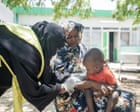
Across the world, communities are navigating a series of challenges that speak to the need for resilience and adaptation. From a global decrease in vaccination rates affecting vulnerable populations to wildlife interactions impacting human safety, and agricultural concerns due to livestock diseases, each situation calls for a balanced and proactive approach to ensure the well-being and safety of people and their environments.
In Sudan, children face a mounting health crisis due to a sharp decline in vaccination rates. Once exceeding 90% in 2022, the number has dropped significantly, leading to concerns about the spread of infectious diseases. The World Health Organization has reported that Sudan now holds the lowest vaccination rate globally, a situation exacerbated by ongoing civil unrest and a humanitarian crisis. This decline poses a grave threat to young children, who are increasingly vulnerable to diseases such as measles, polio, and cholera. Humanitarian organizations emphasize the need for coordinated global support and innovative solutions to restore and even surpass previous immunization levels to safeguard future generations.
Meanwhile, in Japan, the community of Hokkaido is dealing with a different kind of hazard, as a series of bear encounters has led to the declaration of a state of emergency in one northern town. The recent disappearance of a hunter on Mt Esan, coupled with the discovery of a rifle and bloodstains near where a brown bear was sighted, highlights the pressing importance of human-wildlife coexistence strategies. With at least two fatal bear attacks reported this month, local authorities are working diligently to locate the missing individual and to implement measures that will protect residents while preserving the bear population. Initiatives include increasing public awareness about bear behavior and more rigorous management of waste to prevent attracting bears to inhabited areas.
Turning to Europe, livestock farmers in the French region of Savoie are grappling with concerns over an outbreak of lumpy skin disease, an infectious virus that affects cattle and can be fatal to them. The official reports indicate that approximately a dozen farms have been affected. In response, there is ongoing debate and a measure of resistance among farmers regarding the euthanasia of impacted cattle, which is mandated to control the disease’s spread. Farmers, supported by local agricultural unions and parts of the community, are advocating for alternative solutions that could balance disease control with humane treatment of animals. The cross-sector collaboration aims to find effective methods to manage and potentially eradicate the disease without unnecessarily severe impacts on animal welfare and the livelihoods of farmers.
While each issue varies widely in nature, the common thread linking these challenges is the necessity for thoughtful action and community engagement. Efforts to resolve these problems are ongoing through partnerships between local authorities, international organizations, and the affected communities. By sharing knowledge and resources, there is hope for sustainable and effective responses that address both immediate needs and long-term goals. In this globally interconnected landscape, the development and sharing of strategies to cope with health and environmental challenges can serve as a beacon of resilience and advancement, inspiring a concerted effort toward protecting both our populations and the planet.
Source: {link}
